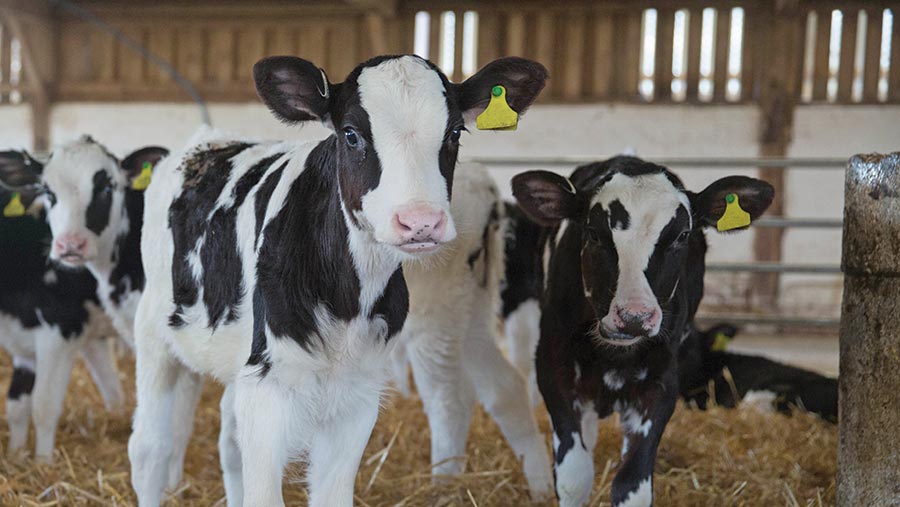4 steps to ensure heifers are on track to calve at 24 months
 © Tim Scrivener
© Tim Scrivener We all need to build more resilient businesses in this tough world of market volatility and the starting point on all dairy farms is the birth of the calf.
What we do after that will determine whether the heifer is an asset worth more than £2,000 or a liability that will only cost the business.
Many studies have shown how cost-effective calving at two years is, whatever system you farm. The average difference in the cost of rearing heifers between the top 25% and the bottom 25% of herds is in the region of £800.
See also: How to help underperforming heifers hit growth targets
That extra costs will in part be down to waste (wasted time, wasted feed and poor health performance or mortality), but the majority will be down to delayed age at first calving.
On average, a heifer costs an extra £3/day to rear after 24 months. Heifers that calve after 24 months have a reduced lifetime yield and are more likely to be culled from the herd.
Chloe Cross, from Kite Consulting, explains what steps dairy farmers can take to ensure heifers are on the right track for calving at two years.
1. Monitor growth rates to ensure you hit breeding targets
To calve at 730 days (two years), heifers needs to be pregnant by day 445, which means they need to be big enough to start serving at 13 months (390 days) of age to be in calf by 15 months.
To hit these targets, you need to monitor growth rates from birth and correct any issues before they affect your age at first calving. Are the calves reaching at least two-and-a-half times their birth weight by weaning?
Weighing, weight banding or measuring height at withers are all options. You don’t need to necessarily weigh every animal, you can use a sentinel animal in each peer group to weigh frequently in order to ensure target growth rates are achieved.
Ideally you want a heifer to have the chance to express heat at least once before mating in order to give you information to base subsequent mating timings on
2. Keep calf housing clean to avoid disease
As well as nutrition, calves respond to hygiene. Simply installing a steam cleaner or pump-out disinfectant bottle in the youngstock sheds can make a huge difference – if a job is easy to do, it will get done.
Ensure you have high standards of cleanliness and hygiene and use protocols so all staff are operating to the same standards. Consistency is key, and calf health and growth will suffer if you’re not getting it right.
3. Ensure a smooth weaning transition to avoid growth checks
Another common stumbling block is the transition between milk-fed and weaned phases.
It is important to have a set routine here. Calves’ appetite is driven by smell, so ensure the feed is fresh every day for calves over the age of two weeks; a small handful will suffice until they begin to nibble at it.
By one month the heifer should be eating 1kg of concentrates a day, rising to 2kg by weaning. As you begin to step the milk feeds down, increase calf pellets until she has ad-lib access.
If feeding in a group, try to monitor how many bags the heifers eat a day and ensure that the feed available also increases at each growth stage.
The second transition from weaning pellets to heifer nuts will be easier, but it is equally as important to monitor their feed intakes and compare this against your target.
Regularly weighing a proportion of the heifers will help you stay ahead of any growth checks and will give an early warning if you get the feed or feed-regime slightly wrong.
4. Create an environment for optimal conception success
The emphasis of heifer rearing is still to achieve a serving weight of 340kg for Holsteins and 220kg for Jerseys, or wither height of 125cm or 110cm, respectively.
Maintaining a steady growth in these rearing stages is important, alongside a comfortable and quiet environment, for optimal conception.
Heifer weight targets (assuming 630kg mature weight)
- Three months – 17% of mature weight
- Six months – 27% of mature weight
- 14 months – 55% mature weight
- 24 months (pre calving) – 90% mature weight
Source: AHDB
